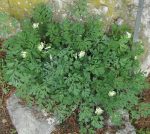 This short-lived evergreen perennial is native to Italy and the Balkans where it grows in rocky woodland areas. It is a membe of the poppy family, Papaveraceae, that also includes bleeding heart and Dutchman’s breeches. Plants form a 12-20″ tall mound of finely divided, gray-green, fern-like leaves. From spring to autumn, fleshy branched stems carry axillary racemes of pendulous, 4-petaled flowers that are white with pale yellow throats. Each flower is fragrant, 5/8″ long, and tubular with a spur on one end. Plants do best in cool climates and will grow in the crevices of walls and pavements in full sun to part shade. They are also a good choice for cottage, woodland, and rock gradens The genus name, Corydalis, comes from he Greek word korydalis meaning lark and refers to the spurs of the flowers that resemble the spurs of some larks. The specific epithet, ochroleuca, is the Latin word meaning yellowish-white and refers to the color of the flowers.
This short-lived evergreen perennial is native to Italy and the Balkans where it grows in rocky woodland areas. It is a membe of the poppy family, Papaveraceae, that also includes bleeding heart and Dutchman’s breeches. Plants form a 12-20″ tall mound of finely divided, gray-green, fern-like leaves. From spring to autumn, fleshy branched stems carry axillary racemes of pendulous, 4-petaled flowers that are white with pale yellow throats. Each flower is fragrant, 5/8″ long, and tubular with a spur on one end. Plants do best in cool climates and will grow in the crevices of walls and pavements in full sun to part shade. They are also a good choice for cottage, woodland, and rock gradens The genus name, Corydalis, comes from he Greek word korydalis meaning lark and refers to the spurs of the flowers that resemble the spurs of some larks. The specific epithet, ochroleuca, is the Latin word meaning yellowish-white and refers to the color of the flowers.
Type: Evergreen herbaceous perennial
Bloom: Racemes of fragrant, pendulous, tubular flowers that have white petals with yellow throats; spring to autumn in cool moist climates
Size: 12-20″ H x 12-24″ W
Light: Dappled sun to full sun
Soil: Humus rich, consistantly moist, well-drained; plants may die back if they dry out
Hardiness: Zones 5-7
Care: Low maintenance
Pests and Diseases: None of significance
Propagation: Seed, division
Companion Plants: Lewisia ‘George Henley’, Campanula ‘Blue Waterfall’ ,Brunnera ‘Hadspen Cream’,
Photo Credit: Wikimedia